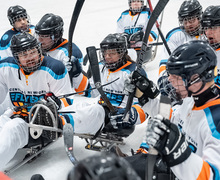By adding a full-time therapist, Syracuse Athletics wants to put mental health at the forefront
Daily Orange File Photo
Many Syracuse athletes practice on South Campus. Now, players can walk this field in the Ensley Athletic Center to Manley Field House for mental health counseling.
For some athletes, the response to injury can prompt mental health issues such as anxiety, depression and sleep disturbance, according to the NCAA.
That’s why, after Syracuse athletes undergo surgery, Assistant Athletics Director for Sports Medicine Brad Pike now offers them an idea for dealing with what may follow.
“Hey, the counselor is available. It’s completely cool to do it,” Pike tells athletes. “… We kind of strongly push them to see our therapist,” Pike said later.
Roughly one in five adults in the United States suffer from mental illness, according to the National Alliance on Mental Illness. Two experts and numerous studies suggest that athletes may be at greater risk. NBA star Kevin Love and NFL star Brandon Marshall are among athletes to have gone public with their battles with mental illness.
Last September, Syracuse Athletics made two therapists available exclusively for athletes. Both worked 20 hours per week. On March 19, SU Athletics positioned a single full-time therapist for athletes.
“Our mental health services were a direct result of input that we got from student athletes at ACC meetings and at the NCAA convention in 2017,” Syracuse Director of Athletics John Wildhack said. “I came back and said, ‘We’ve got to provide more support services, more help in that area.’”
A 2016 NCAA survey of nearly 21,000 Division I, II and III college athletes indicated that about 30 percent of students self-reported feeling “intractably overwhelmed” a month prior to the survey. A 2016 Drexel University study surveyed 465 athletes at Division I programs and found that nearly 24 percent of the athletes reported a “clinically relevant” level of depressive symptoms, and 6 percent reported moderate to severe symptoms.
In March 2016, the NCAA published a guideline with best practices regarding mental illness, which includes encouraging schools to provide a therapist. Before that, the NCAA didn’t have a set of practices laid out.
“Because college athletes are expected to play at such a high level of competition, especially in Division I, they have enormous pressure to perform and maintain their place on a team,” said Ellen deLara, an associate professor emerita in the David B. Falk College of Sport and Human Dynamics. “This can help to create an atmosphere for them that promotes a lot of stress, which in and of itself can lead to anxiety and depression.”
Athletes can also use medication, mindfulness training and yoga to promote a healthier atmosphere, deLara said.
deLara said an important first step to better understanding the mental health issues associated with athletes lies in uprooting the stigma that poor mental health is tied to weakness. She said the stigma may trace back to ancient Greek sculptures, as they represent the “perfect specimen of a person.” In a similar way, athletes are considered to be a model, she said.
In a growing “achievement-based culture,” there may be an increase in the percentage of athletes experiencing mental health issues over the next five to 10 years, said Robin Scholefield, a psychologist at the University of Southern California and associate director of the school’s clinical and sport psychological services for athletics. She consults with Division I and Olympic athletes. Oftentimes, she suggests mindfulness: The process of bringing one’s attention to the present moment through exercises focused on the breath.

Kevin Camelo | Digital Design Editor
Scholefield said the key distinction between how athletes respond to mental health issues versus nonathletes is that athletes usually register fatigue and lack of motivation before sadness. This contrasts with nonathletes, who may experience sadness first.
She said signs of stress specifically among college athletes include complaints of stomach or headaches, as well as dizziness.
Mood swings, increased irritability and emotional outbursts also are signs because they may be an indication of an underlying stress issue, Scholefield said. The pressures of attending every practice, as well as quickly recovering from injury, contribute to athletes’ mental health issues.
Cory Wallack, the director of Syracuse’s Counseling Services, said the primary benefit of a therapist in Manley resides in accessibility. He noted that last school year the trek from Manley Field House to the Counseling Center on Walnut Place is “about as far across SU property one can go.” Should demand increase, SU Athletics may expands its therapy services, he said.
“Their ability to blend and be just another student is not possible,” Wallack said. “Where else do you have a student who can also be criticized as readily by the student population in an acceptable manner? Think about the missed free throw, the missed touchdown catch, the fill-in-the-blank. There’s just a heap ton of pressure there.”
Wallack said members of all SU teams utilize the service.
“Around the country, I think we’re on the front end of what’s about to be an explosion,” Wallack said. “You’re going to see a whole heap of specialists who are working with college student-athletes. The NCAA is treating mental health as a public health crisis at the level it needs to be treated.”
Wallack said it’s integral that anyone, including athletes, not wait until they have mental health issues before seeing a therapist. That aligns with the NCAA report released two years ago: The guidelines emphasize mental health screening tools and written mental health referral plans — all before athletes even appear in their first collegiate athletic event.
“We’re trying to get the point that mental health is just as important as physical health,” Pike said. “Or probably more important than physical health.”
Published on April 30, 2018 at 10:31 pm
Contact Matthew: mguti100@syr.edu | @MatthewGut21





